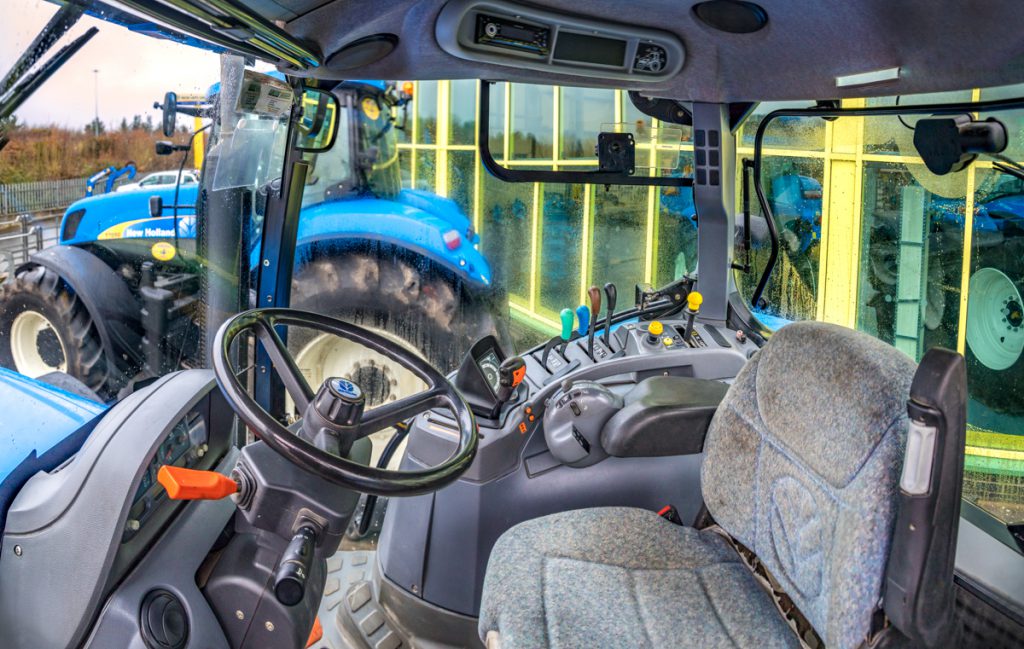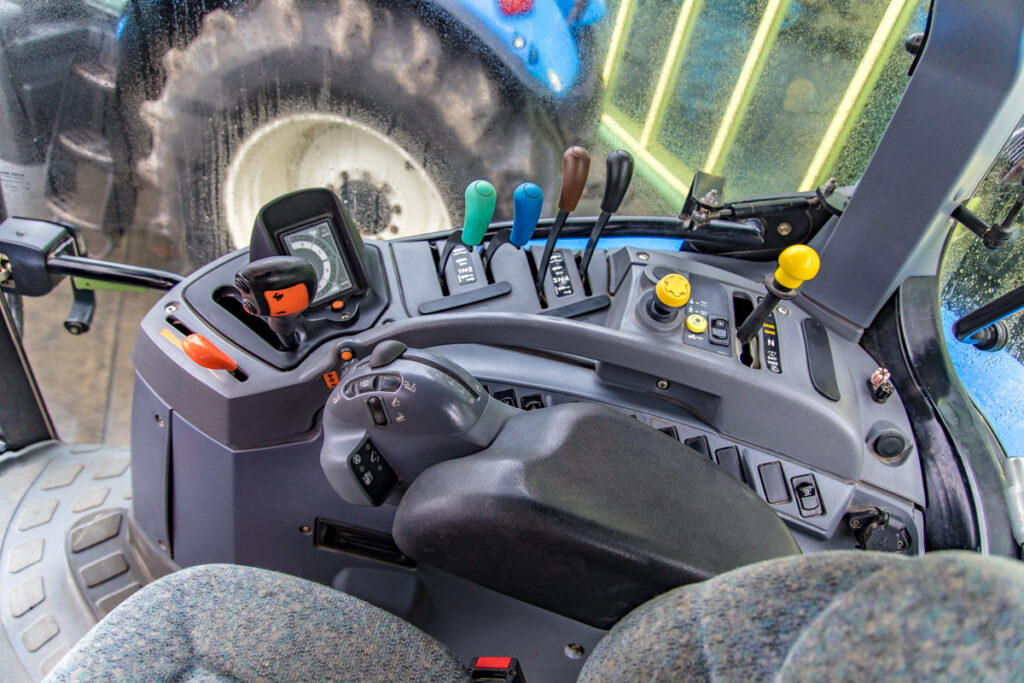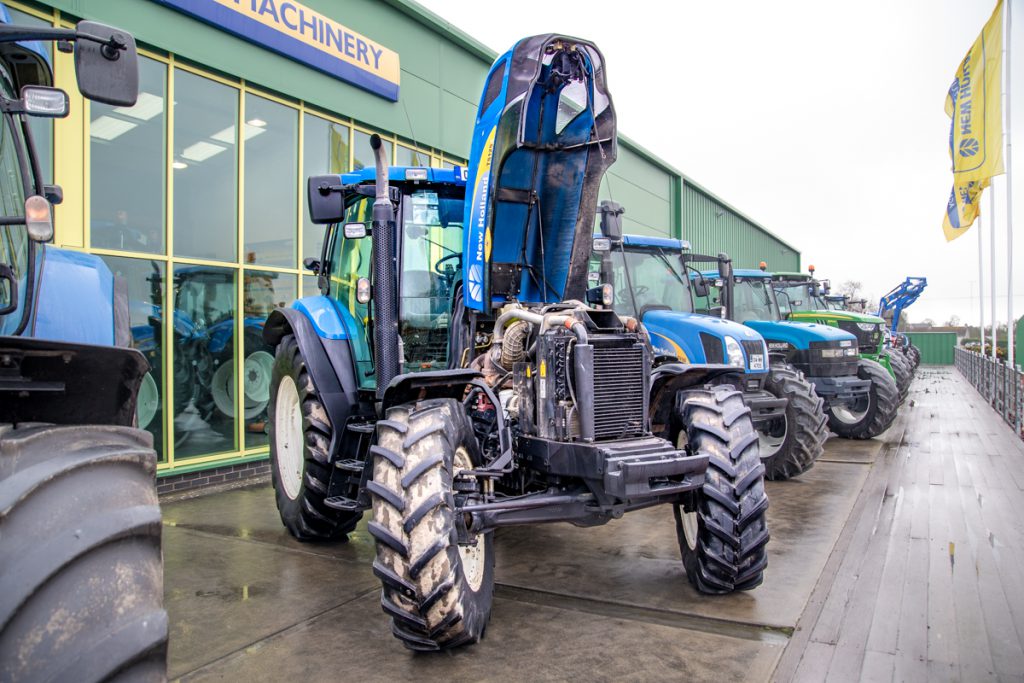The New Holland factory in Basildon, Essex – just east of London – was originally opened in 1964 to manufacture Ford tractors, after space ran out at the famous Daghenham plant. The factory was sold to the Fiat empire in the 1990s after Ford left the tractor business – ultimately joining the New Holland brand.
They have proven to be reasonably sturdy machines with a good reputation.
The initial TS models were launched in 1997 and were largely based on the 40 series (Ford) tractors they replaced. They were home to the old but venerable Powerstar engines, which were approaching the end of their life due to ever-tightening emissions rules.
After a thorough update, the TS-A series was released in 2003; it was notable for its new, modern cab and ‘NEF’ engine – developed by CNH, Iveco and Cummins.
Smaller models were powered by a four-cylinder, 4.5L engine; larger models were fitted with a six-cylinder, 6.7L version. All engine types were turbo-charged.
Three models were offered – Delta, Plus and Elite; these denoted differing levels of standard equipment. But, with a detailed options list, buyers could cherry-pick countless configurations.
Focusing on the six-cylinder models, the TS115A was the smallest – with 116hp (ISO) on tap.
It was joined by the TS125A and TS135A. These came with a common-rail engine and an upgraded cylinder head, with four valves per cylinder. They were also available with New Holland’s EPM (Engine Power Management) system – a boost function that upped available power in higher gears and during PTO work.
EPM enabled the TS125A (normally 125hp) to churn out up to 147hp. It allowed the TS135A (136hp) to max out at 162hp (on boost).
Curvy cab
The TS-A ‘Horizon‘ cab was a new design, with a four-post frame and full-length doors. Sitting slightly lower on Delta versions, in-cab noise levels of 72dB were considered good.
An air-suspended seat – fitted to most tractors – also helped to bolster comfort.
Vents on the dash helped to keep the big windscreen clear. A tidy-sized, see-through roof panel was a boon for loader work.
Switch-gear and controls have proven reasonably durable. However, the work-lights are operated through a touch-pad system (which may or may not be to everyone’s liking). It’s worth noting that this switch-pad can burn out, if additional aftermarket beacons or work-lights are fitted; an upgraded wiring loom with relays is available to get around this.
Which ‘box’?
A variety of transmission options was available. The lesser-spotted Synchro Command 12F 12R manual shuttle ‘box’ was sometimes seen on smaller tractors.
A durable, twin-gearstick, two-speed powershift ‘box’ – known as Dual Command – offered 24F 24R speeds.
The more expensive 16F 16R Electro Command (semi-powershift) ‘box’ was often fitted to bigger TS-A models.
When configured for 50kph, Electro Command tractors could be equipped with a ‘direct drive’ 17th gear – for improved power delivery on the road at full pelt.
Both Dual Command and Electro Command transmissions were available with either a creeper or 50kph top speed. However, it was not possible to specify both these options – due to manufacturing constraints.
50kph tractors were, by default, fitted with air brakes, front axle brakes and Terraglide front axle suspension – optional on 40kph versions.
Terraglide’s active system uses a potentiometer, valve block and accumulators – to set ride height and provide a degree of damping. Although generally reliable, wear can occur at the ball joint (at the axle pivot) – leading to a ‘knock’ while driving.
To facilitate this trickery, the front weight carrier was attached to the axle – to allow the weight carrier to swing out of the way of the wheels at full lock. This can result in a slightly ‘twitchy’ driving experience – especially at 40kph (the highest speed available on SuperSteer-equipped tractors).
Another interesting option was ‘Fast Steer‘. Where fitted, when travelling below 10kph, tugging on an inner ring within the main steering wheel changed the steering ‘ratio’ – allowing full lock to be achieved with just one twirl of the steering wheel.
A 600-hour service interval is specified for the engine oil/filters and hydraulic charge filter. Back-end oil and filter intervals are 1,200 hours. Service access to the engine is good, with the one-piece bonnet lifting on gas struts.
PTO and hydraulics
An electro-hydraulically engaged PTO – with speeds of either 540/1,000rpm or 540/540E/1,000rpm – was available. A ground-speed PTO was on the options list – and did make its way onto some tractors.
Electro Command Plus models came with closed-centre, load-sensing (CCLS) hydraulics as standard, delivering up to 113L/min from a variable-displacement piston pump. Smaller models made do with 63 or 80L/min output – from a simpler, fixed-displacement pump.
Mechanical draft control was standard on Delta models; electronic linkage control was reserved for Plus/Elite tractors. That said, actual on-the-ground specifications can vary – depending on how individual tractors were configured at the time of order. The best advice is not to make too many assumptions; check the exact fittings on any tractor you inspect.
It is possible to cost-effectively re-condition this style of hitch. Later models often came fitted with a (hydraulic) push-back hitch, which is practically trouble-free.
The factory-fitted ‘FL’ loaders came from Stoll; lift capacities were 2.3-2.6t. Hydraulic and mechanical self-leveling versions were available.
These are relatively strong loaders, but need to be judged on actual condition when buying second-hand. As with any loader, money saved on grease can easily be swallowed up by repairs down the line!
- Engine: 6.7L; six-cylinder; turbo-charged, common-rail;
- Power: 126hp or 154hp (with boost; ISO);
- Torque: 566Nm @ 1,400rpm or 606Nm @ 1,600rpm (with boost);
- Weight: 5.0t (depending on specification);
- Rear lift capacity: 6.6/7.8t;
- Transmission top speed: 40/50kph;
- Hydraulic output: 80L/min; 190 bar maximum or 113L/min; 210 bar (CCLS);
- Fuel capacity: 254/236L (standard/SuperSteer);
- In-cab noise levels: 72dB.
Prices for six-cylinder TS-A models (ex-farm or from an auction, for example) can start from €23,000 plus VAT, rising to €35,000 plus VAT for clean, warrantied examples with low hours (typically from a dealer).
Smaller four-cylinder tractors can typically be had from €18,000 to €26,000 (plus VAT).
Thanks to Armstrong Machinery, The Five Roads, Lusk, Co. Dublin, for its assistance in producing this article.













